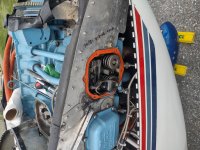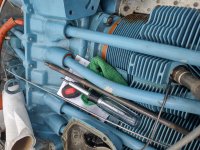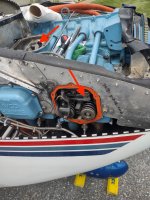I knew it would happen one day, I just didn't figure it would be today that I would declare an emergency. During steep turns near Morgantown PA I was greeted by a thump and loss of power. It was clear that I'd lost a cylinder so I turned and headed for KLNS. Its all fields between the two so the pucker factor wasn't that bad. Well, at least until the oil started to sprinkle onto the windscreen.
The tower was kind enough to get me to the ground right away and even give the runway a good scrub after I'd taxied over to Florintino's for a nice lunch to reflect on today's adventures.
Once the top cowl was pulled, I found a broken exhaust side stud that had let its parts fall into the intake side assembly. The intake pushrod was bent, it's tube was bent as well. Obviously I need to replace the obvously broken parts. What knowlege and operating experience can you guys bestow upon me reguarding cam health? Should I pull or replace the affected intake lifter? Have you seen cams fail after this sort of event? Any advice on the entire situation here is appreciated.
For reference, the engine is a o-320-H2AD that is 250ish hours since MAJOR by Tropic Air Power. The stud appears to have had a factory defect. Viewing the broken portion, there's a small amount of different grain structure.
The tower was kind enough to get me to the ground right away and even give the runway a good scrub after I'd taxied over to Florintino's for a nice lunch to reflect on today's adventures.
Once the top cowl was pulled, I found a broken exhaust side stud that had let its parts fall into the intake side assembly. The intake pushrod was bent, it's tube was bent as well. Obviously I need to replace the obvously broken parts. What knowlege and operating experience can you guys bestow upon me reguarding cam health? Should I pull or replace the affected intake lifter? Have you seen cams fail after this sort of event? Any advice on the entire situation here is appreciated.
For reference, the engine is a o-320-H2AD that is 250ish hours since MAJOR by Tropic Air Power. The stud appears to have had a factory defect. Viewing the broken portion, there's a small amount of different grain structure.







